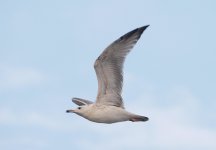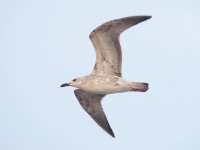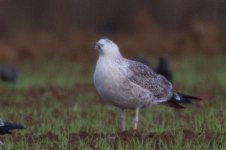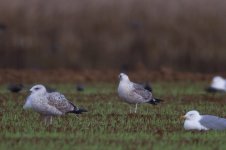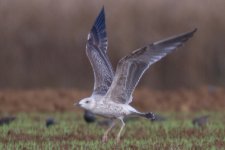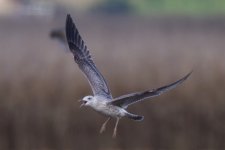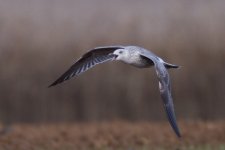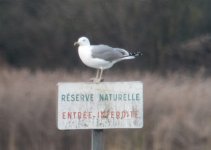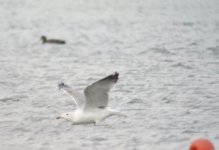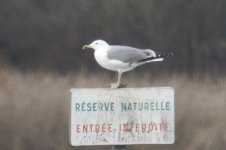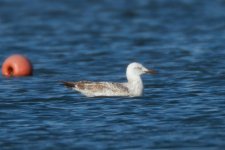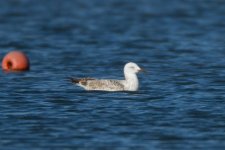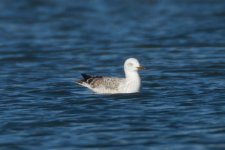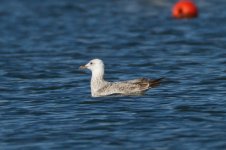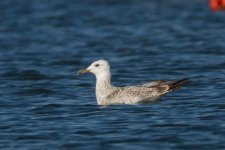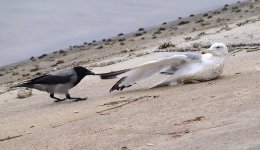-
Welcome to BirdForum, the internet's largest birding community with thousands of members from all over the world. The forums are dedicated to wild birds, birding, binoculars and equipment and all that goes with it.
Please register for an account to take part in the discussions in the forum, post your pictures in the gallery and more.
You are using an out of date browser. It may not display this or other websites correctly.
You should upgrade or use an alternative browser.
You should upgrade or use an alternative browser.
gulls (3 Viewers)
- Thread starter lou salomon
- Start date
More options
Who Replied?lou salomon
the birdonist
nice cristian. is that a 3rd cycle cach in the first pic? i mean, do you have any shot with its upper wings visible? for a 2nd cycle p10 mirror would be huge.
Tib78
Well-known member
Question gents: How common is it to see a YLG in full juvenile plumage in early november?
Edit: Lou, regarding Cristian's bird above: I think the pattern of P5, discernable owing to translucency (i.e there is a contrasting black tip), indicates a 3rd cycle.
Edit: Lou, regarding Cristian's bird above: I think the pattern of P5, discernable owing to translucency (i.e there is a contrasting black tip), indicates a 3rd cycle.
Last edited:
lou salomon
the birdonist
i've never seen one, thibaut. but i have seen either nominate michahellis and atlantis (well, the ones from canaries) in september in m.o.less full juvenile plumage. i think a fully juvenile micha in november should be a lesser black-back 
as for cristian's cach: p5 mark is pretty large and as such possible in a 2nd cycle (in which you already can well see the contrast between dark primary portions and paler brown basal parts) and there are some darker marks on inner primaries (p1-4) too, so it would be a fairly retarded 3rd cycle cachinnans. bill pattern is more in line with a 2nd cycle one and tail also has a lot of black. there exist 2nd cycle cachis with large/longish p10 marks but they are not common, that's why i was asking. peter (sneaking around ) has a nice photo of such a bird.
) has a nice photo of such a bird.
as for cristian's cach: p5 mark is pretty large and as such possible in a 2nd cycle (in which you already can well see the contrast between dark primary portions and paler brown basal parts) and there are some darker marks on inner primaries (p1-4) too, so it would be a fairly retarded 3rd cycle cachinnans. bill pattern is more in line with a 2nd cycle one and tail also has a lot of black. there exist 2nd cycle cachis with large/longish p10 marks but they are not common, that's why i was asking. peter (sneaking around
Last edited:
Tib78
Well-known member
i think a fully juvenile micha in november should be a lesser black-back
I would have probably said the same thing...But have a look at the pics and see what you think.
Compared to several YLG (1st winter and adults) present next to it*:
- same size, actually among the biggest individuals
- legs seemingly a bit longer than an adult YLG next to it, seen in direct comparison
*interestingly the bird was hanging around with the group of YLGs while the LBBG were on their own, a bit further away.
Attachments
lou salomon
the birdonist
very weird. pale tipped primaries, white head, pale underparts, venetian blind (though acceptable for some graellsii), size and structure and, what appears to be a micha-tail, - all say YLG! don't know if such a thing is known...
Cristian Mihai
Cristian Mihai
nice cristian. is that a 3rd cycle cach in the first pic? i mean, do you have any shot with its upper wings visible? for a 2nd cycle p10 mirror would be huge.
Unfortunately I don't have a picture with the upper part of the wing.
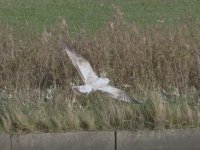
This gull was in NW England today.It joined a group of gulls feeding on bread scraps for a minute or two.Initially I thought it was a Ring-billed because of the size( clearly bigger and longer winged than the Commons with it) , the large pale-pink based bill and most of all the tail pattern. However I would expect a more extensive pale window on the inner primaries on a RBG. Could this be a hybrid or even an "eastern-type" Common Gull?
lou salomon
the birdonist
hi thibaut,
it's a 3cy caspian gull but could have some argentatus genes: bill shape (esp. at tip), smallish p10 mirror, no p9 mirror and odd tertial pattern for pure caspian. still, surely not any pure breed of the other contenders. however, with these traits it's well within cachinnans variation!
it's a 3cy caspian gull but could have some argentatus genes: bill shape (esp. at tip), smallish p10 mirror, no p9 mirror and odd tertial pattern for pure caspian. still, surely not any pure breed of the other contenders. however, with these traits it's well within cachinnans variation!
Tib78
Well-known member
Thanks Lou.
But why isn't it a mich then?
Honestly I have been swaying between cach and mich but finally settled for a mich mostly because of the features you mention about the primary pattern (and seemingly lots of black on underside of p10 but hard to assess). Also jizz somewhat not perfect for Caspian to my eyes.
But I reckon the head is very white.
And compared to this one: http://www.clarebirdwatching.com/archives/3762 I can't see much difference (well gulls have that thing about them: they all look the same!
)
But why isn't it a mich then?
Honestly I have been swaying between cach and mich but finally settled for a mich mostly because of the features you mention about the primary pattern (and seemingly lots of black on underside of p10 but hard to assess). Also jizz somewhat not perfect for Caspian to my eyes.
But I reckon the head is very white.
And compared to this one: http://www.clarebirdwatching.com/archives/3762 I can't see much difference (well gulls have that thing about them: they all look the same!
)
Last edited:
lou salomon
the birdonist
structure:
- bill is long and narrow (not high)
- eye is small and oval and placed forward and high in the head (-> 3rd pic)
- in the first pic you can see the high bend on breast, a flat belly and a "fat"-bump behind legs, all very typical for caspian gull.
wingtip pattern:
- 3rd cycle micha rarely shows such a large/long p10 mirror. same aged caspians can have a very large mirror plus a p9 mirror, they can have a smaller p10 mirror (like this one) and no p9 mirror but some can have a small p10 mirror only, without any p9 mirror - birds which for a long time really confused me, things like e.g. this: http://www.lou.bertalan.de/gulls/m_phi.php?bid=150&grp=cachinnans 4-5cy january-june or this: http://www.lou.bertalan.de/gulls/m_phi.php?bid=1422&grp=cachinnans 4-5cy january-june
- ventral p10 tongue: hard to asses (esp. its end which in caspian ideally would show that nice rectangle) but unfortunately a short p10 tongue is found in quite some 3rd cycle cachs...see the above linked bird with the small p10 mirror (link 2).
- more important: p7-9 show long tongues with rounded ends eating into the black wingtip, something which is fairly typical for cachi, hardly found in 3rd cycle micha (more black in these primaries, tongues not "eating" into the black block.
- in the 2nd pic you can see some dorsal pale tongues in the outer primaries (right wing) - this really excludes michahellis!
- white head can be found in some 3rd cycle michas too at this time of year but surely is rarer than in cachi
- GC pattern: very soft, only a dark hue which is found in some michas too but much rarer than this rel. common type of 3rd cycle cachi.
ergo, a cachinnans - possibly looking odd due to HG genes (the eastern german/polish melting pot produces more and more frankensteins )
)
cheerio
- bill is long and narrow (not high)
- eye is small and oval and placed forward and high in the head (-> 3rd pic)
- in the first pic you can see the high bend on breast, a flat belly and a "fat"-bump behind legs, all very typical for caspian gull.
wingtip pattern:
- 3rd cycle micha rarely shows such a large/long p10 mirror. same aged caspians can have a very large mirror plus a p9 mirror, they can have a smaller p10 mirror (like this one) and no p9 mirror but some can have a small p10 mirror only, without any p9 mirror - birds which for a long time really confused me, things like e.g. this: http://www.lou.bertalan.de/gulls/m_phi.php?bid=150&grp=cachinnans 4-5cy january-june or this: http://www.lou.bertalan.de/gulls/m_phi.php?bid=1422&grp=cachinnans 4-5cy january-june
- ventral p10 tongue: hard to asses (esp. its end which in caspian ideally would show that nice rectangle) but unfortunately a short p10 tongue is found in quite some 3rd cycle cachs...see the above linked bird with the small p10 mirror (link 2).
- more important: p7-9 show long tongues with rounded ends eating into the black wingtip, something which is fairly typical for cachi, hardly found in 3rd cycle micha (more black in these primaries, tongues not "eating" into the black block.
- in the 2nd pic you can see some dorsal pale tongues in the outer primaries (right wing) - this really excludes michahellis!
- white head can be found in some 3rd cycle michas too at this time of year but surely is rarer than in cachi
- GC pattern: very soft, only a dark hue which is found in some michas too but much rarer than this rel. common type of 3rd cycle cachi.
ergo, a cachinnans - possibly looking odd due to HG genes (the eastern german/polish melting pot produces more and more frankensteins
cheerio
lou salomon
the birdonist
with the new pic alone i'd have ID-ed it as cachi, even though p10 tongue seems to be really short.
Tib78
Well-known member
Thanks Lou. There has been quite a bit of a debate on this bird, but the consensus is Caspian.
Another bird from today:
Another bird from today:
Attachments
lou salomon
the birdonist
nice ibis-bill caspian that is 
Cristian Mihai
Cristian Mihai
lou salomon
the birdonist
man o man, what's going on again on lacul morii...:C:C:C
stunning pic though, cris. seems to be an adult pontic being weakened by the malade going on in that lake. could you or maybe one from sor ask a (statal?) hydrologic institute if there has been an investigation concerning the water quality and possible sources of real polution in that lake during the last 3 years?
stunning pic though, cris. seems to be an adult pontic being weakened by the malade going on in that lake. could you or maybe one from sor ask a (statal?) hydrologic institute if there has been an investigation concerning the water quality and possible sources of real polution in that lake during the last 3 years?
Last edited:
Cristian Mihai
Cristian Mihai
I sent to SOR information about what I found there on November 12th. They will contact the authorities.
lou salomon
the birdonist
I sent to SOR information about what I found there on November 12th. They will contact the authorities.
:t:
Similar threads
Users who are viewing this thread
Total: 4 (members: 0, guests: 4)




